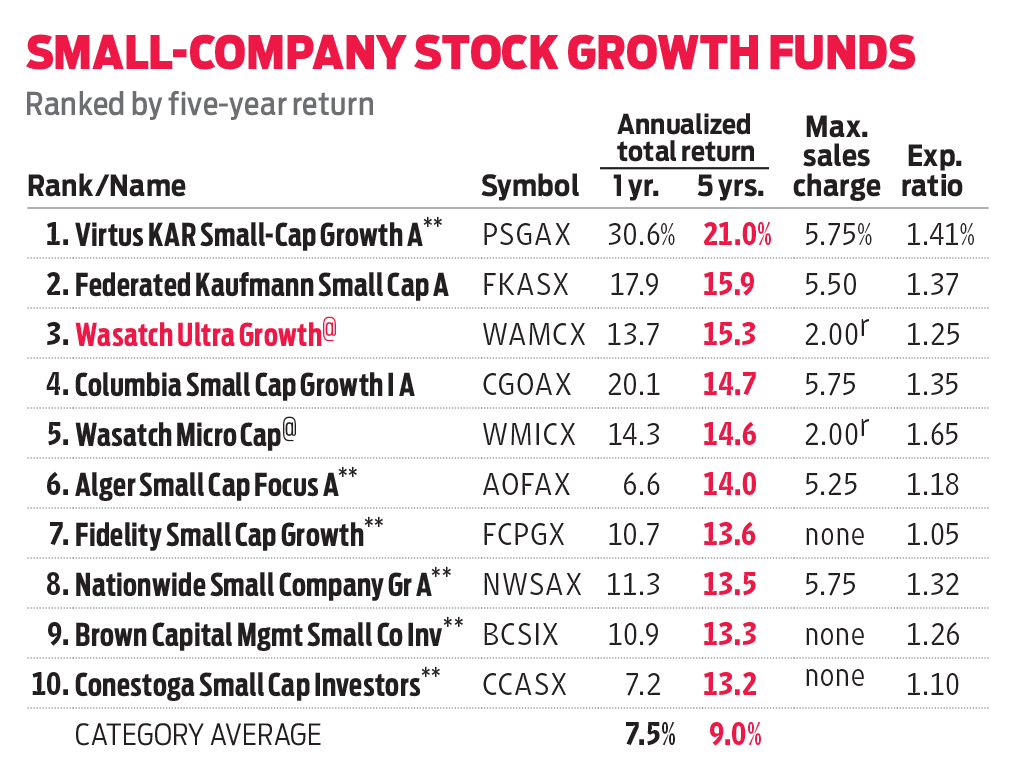Wasatch Ultra Growth Targets Industry Disruptors
This fund invests in small firms intent on wiping out the competition.

Investing in small, fast-growing firms isn't for the faint of heart. Over the past 10 years, the Russell 2000 Growth index, which tracks stocks in small, growing firms, has been 42% more volatile than the broad market benchmark, Standard & Poor's 500-stock index. Finding a winning firm still in its infancy can provide a huge payoff, but investors hoping to get in on the ground floor with the next Amazon.com (symbol AMZN) or Netflix (NFLX) are in for bumpy ride.

The fund dedicates about 20% of assets to what Malooly calls ballast stocks—growing firms, such as discount retailer Five Below (FIVE), that are unlikely to be roiled by competition—to add stability to the portfolio's returns.
But the bulk of the portfolio is dedicated to companies that have the potential to unseat the competition. These firms have business models that incumbent firms can't compete with, or they offer lower price points that competitors can't match. Ra Medical Systems (RMED), for instance, makes a sleep apnea treatment for patients who don't want to wear a mask; and Wayfair (W) sells furniture online at low costs. Malooly particularly favors firms with hefty recurring revenues, which he says makes growth in the business more predictable. Firms in Ultra Growth's portfolio boost revenues at a 21%-to-23% annualized clip, on average, says Malooly.

Sign up for Kiplinger’s Free E-Newsletters
Profit and prosper with the best of expert advice on investing, taxes, retirement, personal finance and more - straight to your e-mail.
Profit and prosper with the best of expert advice - straight to your e-mail.
Since Malooly took the helm in early 2012, Ultra Growth has posted an annualized return of 14.8%, an average of 3.3 percentage points per year ahead of the Russell 2000 Growth index. The fund's 1.25% expense ratio isn't a bargain, but it's in line with the typical fund that invests in small, growing firms.
Get Kiplinger Today newsletter — free
Profit and prosper with the best of Kiplinger's advice on investing, taxes, retirement, personal finance and much more. Delivered daily. Enter your email in the box and click Sign Me Up.

Ryan joined Kiplinger in the fall of 2013. He wrote and fact-checked stories that appeared in Kiplinger's Personal Finance magazine and on Kiplinger.com. He previously interned for the CBS Evening News investigative team and worked as a copy editor and features columnist at the GW Hatchet. He holds a BA in English and creative writing from George Washington University.
-
 Customer Services are Strained at the SSA, You Should Plan Around These Federal Holidays
Customer Services are Strained at the SSA, You Should Plan Around These Federal HolidaysIf you have a question or need information from a federal agency, check the federal holiday schedule to make sure you get your business done before they close.
By Donna LeValley
-
 Stock Market Today: No 'Powell Put'? No Problem
Stock Market Today: No 'Powell Put'? No ProblemInvestors, traders and speculators look beyond both another Trump post and more signs of slowing economic activity.
By David Dittman
-
 The Stock Market Is Selling Off. Here's What Investors Should Do
The Stock Market Is Selling Off. Here's What Investors Should DoInvestors started fleeing the equities market en masse in response to the Trump administration's "jaw-dropping" tariffs. But the experts say don't panic.
By Karee Venema
-
 Stock Market Today: Markets Celebrate Trump's Tariff Détente
Stock Market Today: Markets Celebrate Trump's Tariff DétenteConsumer discretionary stocks led 10 of the 11 S&P 500 sector groups well into the green.
By David Dittman
-
 Stock Market Today: Stocks Skid Into Another Risk-Off Turn
Stock Market Today: Stocks Skid Into Another Risk-Off TurnThe promise of the AI revolution can't overcome flickering hopes for a "Fed put."
By David Dittman
-
 How Amazon Stock Became a Member of the 100,000% Return Club
How Amazon Stock Became a Member of the 100,000% Return ClubAmazon's wide moat is one reason it has generated a 100,000%-plus return for investors over the long haul.
By Louis Navellier
-
 Stock Market Today: Stocks Pop on Time-Delayed Tariffs
Stock Market Today: Stocks Pop on Time-Delayed TariffsAll three major U.S. equity indexes rallied to intraday highs following President Trump's latest trade moves.
By David Dittman
-
 Stock Market Today: Stocks Swing Lower as Inflation Fears Rise
Stock Market Today: Stocks Swing Lower as Inflation Fears RiseThe latest consumer sentiment data showed near-term inflation expectations rose to their highest level since November 2023.
By Karee Venema
-
 Amazon Is the Worst Dow Stock After Earnings. Here's Why
Amazon Is the Worst Dow Stock After Earnings. Here's WhyAmazon stock is at the bottom of the Dow Friday as the e-commerce giant's soft outlook offsets a fourth-quarter beat. This is what you need to know.
By Joey Solitro
-
 Stock Market Today: Investors Respond to the Usual Uncertainty
Stock Market Today: Investors Respond to the Usual UncertaintyStocks surged late but the major indexes closed mixed as the search for market leadership continues.
By David Dittman